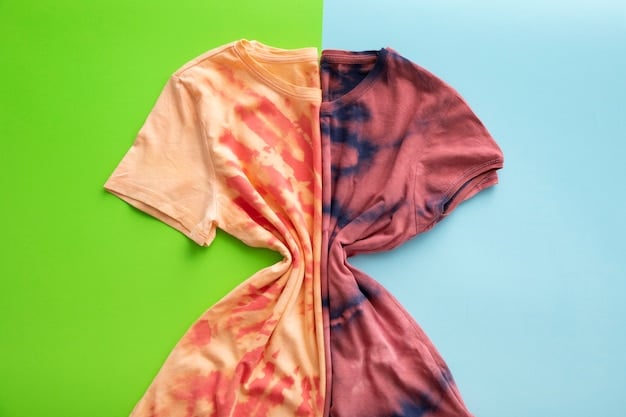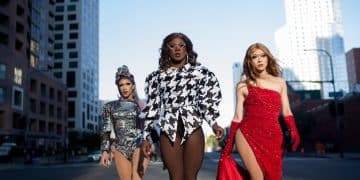US Fashion Sustainability Pledges: Are Brands on Track for 2025?

Advertisements
US fashion sustainability pledges aim to reduce environmental impact, but assessing whether brands are meeting their 2025 goals requires examining their progress, transparency, and the adoption of circular economy practices.
The fashion industry in the United States, known for its rapid trends and significant environmental footprint, has seen numerous brands making public commitments towards sustainability. But with the 2025 deadline looming, the crucial question arises: Are these US fashion sustainability pledges truly translating into tangible change, or are they merely greenwashing tactics?
Advertisements
The Rise of Sustainability Pledges in US Fashion
The US fashion industry’s acknowledgement of its environmental impact has led to a wave of sustainability pledges. From reducing carbon emissions to using recycled materials, brands are outlining their commitment to a greener future. But the road to sustainability is complex, and the effectiveness of these pledges varies significantly.
Why Sustainability Matters in Fashion
Sustainability in fashion extends beyond just using eco-friendly fabrics. It encompasses ethical labor practices, reducing waste, and ensuring a circular economy. Consumers are increasingly demanding transparency and accountability from brands, pushing them to adopt more sustainable practices.
Advertisements
Different Types of Sustainability Pledges
Sustainability pledges come in various forms. Some focus on reducing water consumption during production, while others prioritize fair wages for garment workers. A comprehensive approach to sustainability requires brands to address multiple aspects of their business operations.
- Reducing carbon footprint through renewable energy and efficient logistics.
- Using recycled and organic materials to minimize resource depletion.
- Implementing circular economy models to reduce waste and pollution.
- Ensuring fair labor practices and ethical sourcing throughout the supply chain.
The increased awareness and demand for sustainable practices are driving significant changes within the US fashion industry. Brands are recognizing that sustainability is not just a trend but a necessary shift to ensure long-term viability.

Analyzing the 2025 Sustainability Goals
Many US fashion brands have set ambitious targets for 2025, aiming to significantly reduce their environmental impact. However, evaluating these goals requires a critical look at the specifics and the actions taken to achieve them. Are these goals realistic, and what metrics are being used to measure progress?
Specific Examples of 2025 Goals
Some prominent pledges include reducing greenhouse gas emissions by a certain percentage, sourcing a specific amount of materials from sustainable sources, and eliminating single-use plastics in packaging. These goals provide a benchmark for assessing progress.
Challenges in Meeting the Goals
Meeting these goals is not without challenges. Supply chain complexities, the cost of sustainable materials, and the need for significant operational changes all pose obstacles for brands striving to meet their 2025 targets. Transparency is essential in overcoming these challenges.
The Role of Transparency and Accountability
For consumers to trust sustainability claims, brands must be transparent about their progress and be held accountable. Regular reporting, independent audits, and third-party certifications can help ensure that pledges are not just empty promises.
The assessment of the 2025 sustainability goals within the US fashion industry requires a deep dive into the specific targets set by brands, the challenges they face, and the measures they are taking to achieve these goals, all while maintaining transparency and accountability.
Progress Made by Major US Fashion Brands
Several major US fashion brands have made notable strides towards their sustainability goals. From adopting innovative materials to implementing circular economy initiatives, these brands are paving the way for a more sustainable industry. However, progress is not uniform across the board.
Case Study: Brand A’s Sustainable Material Initiative
Brand A has committed to sourcing 100% of its cotton from sustainable sources by 2025. They have partnered with organic cotton farmers and invested in innovative recycling technologies to achieve this goal. Their progress highlights the potential of sustainable material initiatives.
Case Study: Brand B’s Circular Economy Model
Brand B has launched a take-back program, allowing customers to return used clothing for recycling. This initiative promotes a circular economy, reducing waste and extending the life cycle of garments. Such models are essential for achieving long-term sustainability.
Areas Where Progress Is Lacking
Despite the progress made by some brands, there are areas where efforts are lagging. Ethical labor practices, particularly in overseas supply chains, continue to be a challenge. Additionally, reducing overall consumption and addressing the issue of overproduction remain critical.

The Impact of Consumer Behavior
Consumer behavior plays a crucial role in driving sustainable practices in the US fashion industry. Increased awareness and demand for eco-friendly products can incentivize brands to prioritize sustainability. However, changing consumer habits is a multifaceted challenge.
The Growing Demand for Sustainable Fashion
More consumers are actively seeking out sustainable fashion brands and products. They are willing to pay a premium for ethically made, eco-friendly clothing. This shift in consumer preferences is influencing the industry.
Overcoming the Fast Fashion Mentality
The fast fashion industry promotes a culture of excessive consumption and disposable clothing. Overcoming this mentality requires educating consumers about the environmental and social impacts of their purchasing decisions.
How Consumers Can Drive Change
Consumers can drive change by supporting sustainable brands, buying fewer but higher-quality items, participating in clothing swaps, and recycling their old clothes. Collective action can make a significant difference.
Brand campaigns and educational initiatives that promote sustainable consumption habits are essential for shifting the fast fashion mentality. By educating consumers about the impact of their purchasing decisions, brands can promote responsible consumption and encourage a more sustainable approach to fashion.
The Role of Regulations and Policies
Government regulations and industry policies are essential for promoting sustainability across the US fashion industry. Clear standards, incentives for sustainable practices, and penalties for non-compliance can create a level playing field and drive meaningful change.
Current Regulations and Standards
Existing regulations focus on environmental protection, labor standards, and product safety. However, more specific regulations targeting the fashion industry could further incentivize sustainable practices. Industry-wide standards also play a significant role.
The Need for Stronger Policies
Stronger policies are needed to address issues such as textile waste, water pollution, and ethical labor practices. These policies should be enforced effectively to ensure that brands comply with sustainability standards. Collaboration with international organizations can enhance the impact of these policies.
Incentives for Sustainable Practices
Governments can offer tax breaks, subsidies, and grants to encourage brands to adopt sustainable practices. These incentives can help offset the costs associated with transitioning to more eco-friendly production methods. Supporting research and development in sustainable materials is also crucial.
The implementation of comprehensive regulations and policies is crucial for driving sustainability within the US fashion industry; these regulations must be enforceable, clear, and incentivizing to create a level playing field and ensure meaningful change.
Future Trends in Sustainable Fashion
The future of sustainable fashion in the US is marked by innovation, technological advancements, and a greater emphasis on circular economy models. Brands that embrace these trends will be better positioned to meet the evolving demands of consumers and contribute to a more sustainable planet.
Technological Innovations
Innovative technologies such as 3D printing, blockchain, and AI are transforming the fashion industry. These technologies can enhance transparency, reduce waste, and improve supply chain efficiency. They also enable the creation of customized, on-demand clothing, minimizing overproduction.
The Rise of Circular Economy Models
Circular economy models, including clothing rental services, resale platforms, and recycling programs, are gaining traction. These models extend the life cycle of garments, reduce waste, and promote responsible consumption. Collaboration among brands, consumers, and technology providers is essential for scaling these models.
The Importance of Collaboration
Collaboration among brands, consumers, governments, and NGOs is essential for driving systemic change. Sharing best practices, coordinating efforts, and pooling resources can accelerate the transition to a more sustainable fashion industry. Collective action is key to achieving long-term sustainability.
| Key Point | Brief Description |
|---|---|
| 🌱 Sustainable Materials | Focus on using recycled, organic, and innovative materials. |
| 🔄 Circular Economy | Implementing take-back programs and resale platforms. |
| ⚖️ Regulations & Policies | Stronger enforcement and incentives for compliance. |
| 🛍️ Consumer Behavior | Demand for sustainable products driving change. |
Frequently Asked Questions (FAQ)
▼
The primary goals include reducing carbon emissions, using sustainable materials, promoting fair labor practices, and minimizing waste through circular economy models. These all drive towards a smaller environmental footprint.
▼
Look for certifications like GOTS or Fair Trade, check for transparency in supply chains, and research the brand’s commitment to environmental and social responsibility. It is worth checking for verified sustainable material sources.
▼
Regulations set standards for environmental protection and labor practices. Stronger policies can incentivize sustainable practices and penalize non-compliance, creating a level playing field within the industry.
▼
Circular economy models focus on extending the lifecycle of garments through practices like clothing rental, resale platforms, and recycling programs, reducing waste and promoting responsible consumption.
▼
Technologies like 3D printing, blockchain, and AI can enhance transparency, reduce waste, and improve supply chain efficiency by enabling customized designs and verification of materials.
Conclusion
As the 2025 deadline approaches, it’s evident that while some US fashion brands are making significant strides toward their sustainability pledges, a collective and more aggressive effort is needed. The combined power of consumer awareness, strong governance, and technological breakthroughs will drive the industry forward, ensuring that US fashion sustainability pledges translate into real, lasting change.





